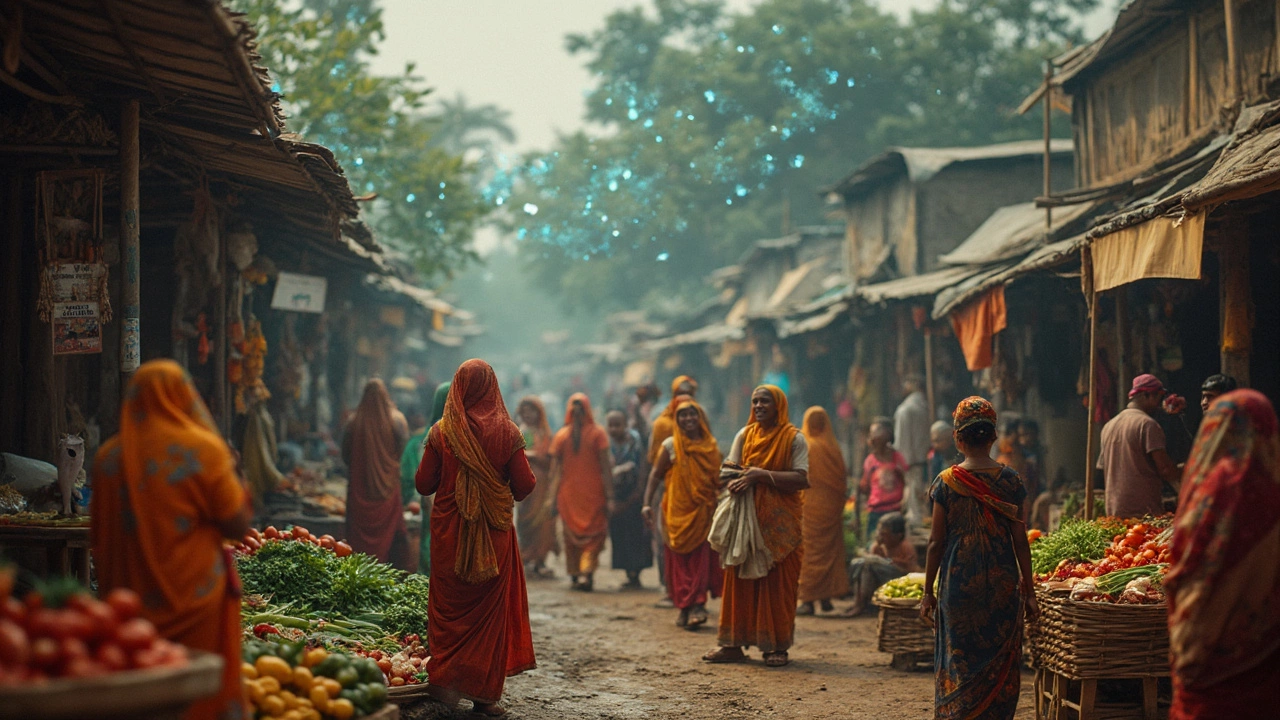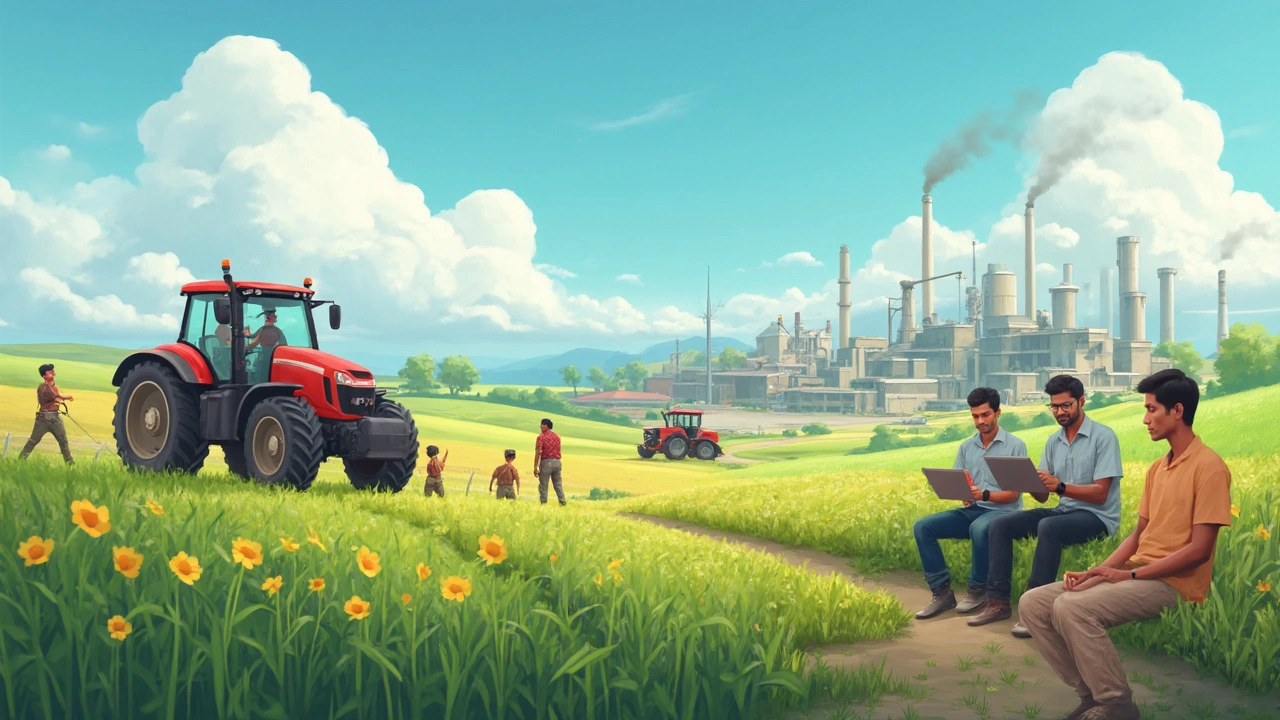Largest Agricultural Companies in the US: Who Really Runs the Farm?
 May, 5 2025
May, 5 2025
Ever wondered who actually puts food on your table? It isn't just the local farmer. In the US, just a handful of agricultural companies control a mind-boggling share of what gets planted, grown, and shipped across the country. These aren't backyard operations. We're talking about names like Cargill, Archer Daniels Midland, Tyson Foods, and Monsanto—firms so huge, they could buy some countries' entire annual crop with what they make in a single year.
This isn't just about crops either. Meat, grains, seeds, and even the stuff that ends up in snack foods—all of it is heavily influenced by these powerhouses. If you're buying chicken at a grocery store or a burger at a fast-food joint, chances are it passed through systems run by these agricultural giants.
Understanding how these companies operate is important if you care about what you eat or where your food comes from. They're not just selling food—they're setting the rules for farming, deciding what's profitable, and even shaping what gets researched in agricultural science. Stick around, and you'll get a no-nonsense look at the biggest players and what makes them so influential.
- Meet the Big Leaguers
- How These Companies Shape Our Food
- Surprising Facts About the Giants
- What Can Smaller Farms Do?
Meet the Big Leaguers
Look up the biggest names in agricultural companies and you'll spot Cargill right at the top. This Minnesota-based firm is the largest privately held company in the US—sometimes even the world. Cargill deals with everything from animal feed to chocolate, but a big chunk of their money comes from trading grains and oilseeds. In 2023, their revenue topped $165 billion. Second is Archer Daniels Midland, better known as ADM. These guys are everywhere in the grain game: sourcing, storing, shipping, and even turning corn into fuel and sweeteners. ADM employs almost 42,000 people and works in more than 170 countries.
Then you have Tyson Foods. Ever bought frozen chicken nuggets? There's a good chance they came from Tyson. This company is America’s top meat processor, and they handle beef, pork, and chicken for huge restaurant chains and grocery stores. They process over 20% of all chicken, beef, and pork produced in the country. In 2023, Tyson pulled in over $53 billion in sales.
Don’t forget Smithfield Foods, which dominates the pork market. It's owned by a Chinese company now, but its factories and farms are all across American states like North Carolina and Iowa. They're the largest pig producer and pork processor in the world.
Of course, you can’t talk about agricultural giants without mentioning the seed and chemical giants. Even though Monsanto was bought by Bayer, its legacy still dictates a lot of how farmers grow corn and soybeans, thanks to genetically modified seed tech. Companies like Syngenta and Corteva also pack a punch, making seeds and crop chemicals farmers use every season. Here's a quick look at some numbers:
| Company | 2023 Revenue (USD) | Main Focus |
|---|---|---|
| Cargill | $165B | Grains, oilseeds, food & agriculture |
| ADM | $96B | Grains, oils, ingredients |
| Tyson Foods | $53B | Meat processing |
| Smithfield Foods | ~$16B | Pork and meat |
These numbers aren't just for bragging rights. They show how much pull these US agribusiness giants have over the food system. From deciding what seeds farmers plant to how farm animals are raised, these companies set the trends that ripple across the world.
How These Companies Shape Our Food
When you break it down, the biggest agricultural companies in the US hold major power over what ends up on your plate. These companies are behind most of the corn, soybeans, and meat that fill American grocery stores. For example, Cargill is so massive it deals with everything from grain trading to beef production, and Archer Daniels Midland is a giant when it comes to processing corn into oil, syrup, and animal feed. Tyson Foods runs so much of the chicken and beef market that their pricing decisions ripple through the whole industry.
They have a say in what kinds of seeds get planted too. The old name Monsanto (now part of Bayer) basically invented the game for genetically modified seeds. That means the company influences which crop varieties grow in the US, and which ones don't.
Here's what these US agribusiness giants really do to shape the food system:
- Control supply chains: They manage everything from seeds and fertilizers to shipping finished products. That makes them gatekeepers from farm to shelf.
- Push certain crops: Corn and soybeans, for example, are everywhere partly because these big players focus on them. It's no accident you see them in so much processed food.
- Set the price: With so much volume going through their hands, they have huge influence over what farmers get paid and what you pay at the checkout.
- Drive food innovation: Whether it’s plant-based meat or fortified snacks, most new products come from the R&D teams inside the corporate giants, not small companies.
- Dominate meat processing: Just four companies, including Tyson and JBS, process about 80% of the beef in the US. That gives them a big say in everything from animal feed to final packaging.
Want some real numbers? Check this out:
| Company | 2024 Revenue (in Billion USD) | Main Products |
|---|---|---|
| Cargill | 177 | Grains, meat, oil |
| Archer Daniels Midland | 96 | Processed grains, oils, animal feed |
| Tyson Foods | 53 | Chicken, beef, pork |
| Bayer (Monsanto) | 51 | Seeds, crop protection |
This concentration means they can dictate not only what is grown and processed, but also how it's done and how safe it is. For everyone who eats food or buys groceries, understanding how these agribusiness giants make decisions is key to making smart choices at the store.

Surprising Facts About the Giants
These agricultural companies are so big that calling them "large" almost feels like an understatement. Here are a few things that'll raise your eyebrows the next time you grab groceries or eat out.
- Cargill isn't just the biggest private company in America—it's bigger than Starbucks and McDonald's combined when it comes to yearly revenue. They handle everything from meatpacking to chocolate, and yes, even a lot of the salt used to melt snow on winter roads is Cargill's doing.
- Ever seen a Lay's chip or Kellogg's cereal ad? The grains and corn that go into massive snacks and cereals in the US often come from companies like Archer Daniels Midland (ADM). They move more grains each day than most small countries produce in a year.
- Tyson Foods packs about 1 in every 5 pounds of chicken, beef, and pork eaten in the US. If you just ate a chicken sandwich, there's a solid chance Tyson had a hand in getting it to you.
- When it comes to seeds, Monsanto (now part of Bayer) is a household name for farmers—and sometimes, even a hot topic of debate. Their genetically modified seeds are planted in over 90% of US soybean acres.
For those who like the numbers, take a look at this:
| Company | 2024 Revenue (Billion USD) | Main Products |
|---|---|---|
| Cargill | 177 | Meat, Grain, Oil, Salt |
| ADM | 101 | Grain, Oilseeds, Ingredients |
| Tyson Foods | 54 | Chicken, Beef, Pork |
| Bayer (Monsanto) | 51 | Seeds, Agrochemicals |
These US agribusiness leaders have a huge say over what ends up in the food supply, from the farm fields to fast-food counters. But here’s a twist—not all of their power is obvious. Some companies own patents on seeds and traits, which means a farmer can’t always just save seeds from last year’s crop and plant them again. You buy new ones, often from the same handful of giants, every season.
So, next time someone says it’s just about “farming,” you’ll know it's more like big business mixed with science, logistics, and a ton of behind-the-scenes action that most folks never hear about.
What Can Smaller Farms Do?
It’s no secret the agricultural companies running the show are huge. But that doesn’t mean smaller farms are out of moves. They can actually stand out in ways the big guys can’t, especially if they’re smart about it.
The best bet for most small and mid-sized farms is to get personal and local. More and more shoppers care about where their food comes from, and that’s a big advantage for farms that can tell their story and sell directly. In fact, according to USDA data from 2022, over 167,000 US farms sold their products through local food channels, bringing in about $11.7 billion. Farmers’ markets, farm-to-table restaurants, and CSA (Community Supported Agriculture) boxes all let smaller operations build loyal customers—something the big brands can’t always pull off.
Here are a few smart moves for small farms trying to stand out the shadow of US agribusiness giants:
- Specialize: Grow unique or in-demand crops, like organic veggies or heritage grains, that big companies overlook.
- Build direct relationships: Connect with local restaurants, chefs, and shoppers who want fresh and local.
- Lean on ag-tech: Use drones for checking crops, soil sensors for saving water, or apps for tracking sales—just like the big guys, but on a scale that fits.
- Join or form cooperatives: Team up with other farms to share costs on equipment, marketing, or distribution. Co-ops have helped farmers gain access to markets that usually favor the giants.
And here’s something surprising: smaller farms are often way quicker to adapt. During the COVID-19 pandemic, small farms were able to switch to online sales way faster than most large farming industry players, giving them quick access to customers locked down at home.
| Strategy | Impact |
|---|---|
| Direct-to-consumer sales | Higher margins, loyal customers |
| Specialty crops | Less competition, better prices |
| Local cooperatives | Better bargaining power, shared resources |
| Tech adoption | Lower costs, better efficiency |
So yeah, the playing field isn’t even, but smaller farms have tricks up their sleeve. If they get creative—and keep that personal touch—they can thrive no matter how big the agricultural giants get.